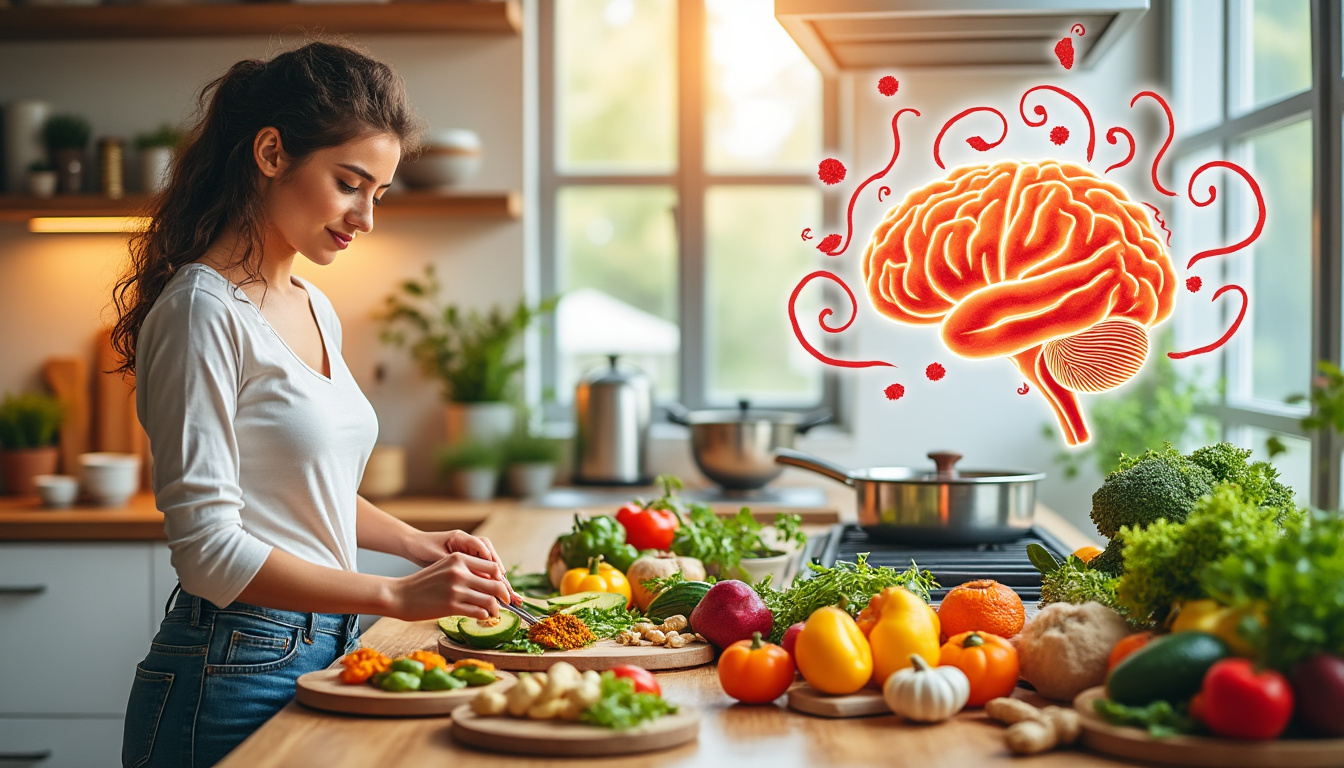Dietary choices shape brain inflammation and cognitive risk: how cooking methods, food choices and simple swaps lower AGE burden and protect brain health in everyday meals.
Dietary choices drive a molecular cascade from the kitchen to the cortex. A recent 2025 NeuroSci review links food, cooking techniques and environmental exposures to the AGE–RAGE axis, showing how common meals can promote oxidative stress, microglial activation and progressive neuroinflammation. Using the experience of Claire, a home cook adapting family meals after a relative’s cognitive decline, this piece explains mechanisms, practical swaps and the tools and products that help reduce risk.
Dietary Choices, AGE–RAGE Signaling and Brain Inflammation
The interaction of advanced glycation end products (AGEs) with the RAGE receptor activates NF-κB, increases reactive oxygen species and impairs mitochondria. This feedback loop sustains chronic inflammation and is implicated in conditions from Alzheimer’s disease to post-viral syndromes.
- Mechanism: AGEs bind RAGE → DIAPH1 → NF-κB → pro-inflammatory genes.
- Outcome: Increased ROS, mitochondrial dysfunction, sustained microglial activation.
- Clinical links: Associations with Alzheimer’s, ME/CFS and long COVID support a systemic view of neuroinflammation.
Claire noticed heavier meals and frequent high-heat grilling correlated with her father’s brain fog. Simple shifts in dietary choices reduced meal browning and improved his energy and post-meal clarity within weeks.
Table: How common cooking methods influence AGE formation and brain risk.
| Cooking Method | AGE Formation | Practical Tip |
|---|---|---|
| Grilling/Roasting | High | Prefer shorter sear times; marinate in lemon or vinegar. |
| Frying | High | Use low-heat alternatives or switch to GreenPan for less overheating. |
| Boiling/Steaming | Low | Emphasize soups, stews and steamed vegetables. |
| Slow-cooking (moist heat) | Low–Moderate | Use Instant Pot or gentle braising to reduce AGEs while preserving flavor. |
Key insight: Targeting the AGE–RAGE axis starts with replacing high-heat, dry-heat techniques—dietary choices determine the biochemical load that reaches the brain.
Dietary Choices, Food Sources and Environmental Contributors
Both endogenous and exogenous AGEs accumulate with age, diabetes and chronic disease. Diets rich in processed meats, refined sugars and saturated fats amplify glycation, while plant-centered patterns reduce intake and provide antioxidants.
- Major exogenous sources: grilled meats, aged cheeses, processed foods and snacks.
- Sugars to watch: fructose is particularly reactive and drives glycation more than glucose.
- Environmental cofactors: heavy metals and additives can impair clearance and increase oxidative stress.
Claire swapped snack choices—switching a processed bar for Blue Diamond almonds and adding Vital Proteins collagen to smoothies made in a NutriBullet. These small changes lowered post-meal spikes and introduced anti-glycation nutrients.
Useful resources and practical recipes helped Claire transition: recipe and dinner tips from chefs eased the switch to lower-AGE meals. See simple home-cooked guidance and meal-prep plans for busy families:
- Samin Nosrat dinner tips for flavor without high heat.
- Ina Garten dinner recipe adaptations to reduce roasting time.
- Easy meal prep recipes that favor steaming and stewing.
- Home-cooked meals: health & finances for budget-friendly swaps.
- Month with Green Chef perspective showing plant-forward options.
Table: Dietary components, impact on AGEs and recommended swaps.
| Component | Impact on AGEs | Recommended Swap |
|---|---|---|
| Processed meats | High exogenous AGE load | Replace with fatty fish (omega-3s, Nordic Naturals) or legumes |
| Refined sugars / fructose | Accelerates endogenous glycation | Choose whole fruits, reduce sugary beverages |
| Aged cheeses | High | Use fresh dairy options or plant-based alternatives |
| Herbs & spices | Antioxidant protection | Add cinnamon, oregano, cloves to meals |
Key insight: Thoughtful dietary choices and ingredient swaps reduce both intake and the metabolic conditions that favor AGE formation.
Strategies to Reduce AGE Burden: Practical Tools, Products and Dietary Plans
Lifestyle interventions remain the most accessible approach. Low-heat cooking, acid marinades and antioxidant-rich foods lower AGE exposure. Pharmacological efforts are still experimental, so culinary changes matter now.
- Cooking tools: Using an Instant Pot, All-Clad slow-cooker settings, and GreenPan non-stick limits high-temperature exposure. Salter scales help portion control, and OXO peelers and gadgets simplify vegetable prep.
- Supplements and foods: Consider targeted omega-3s from Nordic Naturals or formulations such as BrainMD for cognitive support; Vital Proteins can enhance collagen intake while supporting joint and skin health.
- Meal strategies: Batch-cook stews, favor steaming and acid marinades, and include Blue Diamond almonds or other nuts as snacks.
Claire found that swapping a nightly pan-seared steak for a one-pot braised fish and whole-grain pilaf, cooked in an Instant Pot, preserved flavor and reduced household AGE markers. She used a NutriBullet to blend antioxidant smoothies and relied on All-Clad sauce pans for gentle simmering.
Practical checklist for an AGE-lowering kitchen:
- Adopt low-heat cooking for most meals.
- Marinate meats in vinegar or citrus before cooking.
- Choose whole foods and reduce processed items and sugary drinks.
- Incorporate antioxidant herbs and omega-3–rich foods regularly.
- Use kitchen tools (Instant Pot, NutriBullet, Salter scales, OXO gadgets) to simplify healthy cooking.
Further reading and recipe support for transitions are available: Inner Chef home cooking, guidance for children and family meals like children gardening tips and children gardening passion help reconnect families to whole foods.
Key insight: Combining targeted cookware, evidence-based supplements and consistent dietary choices creates a feasible path to lower AGE exposure and support cognitive resilience.
FAQ
How fast can dietary changes reduce circulating AGEs?
Short-term trials show reductions in circulating AGEs within weeks to months when high-AGE foods are avoided and low-heat cooking is used. Individual responses vary with age, renal function and baseline diet.
Do supplements (like BrainMD or Nordic Naturals) replace dietary change?
Supplements can provide supportive nutrients—omega-3s, antioxidants or targeted formulations—but they complement rather than replace food-based strategies and low-AGE cooking methods.
Are certain cooking appliances better for lowering AGEs?
Yes. Moist-heat appliances such as Instant Pot or slow-cookers, and non-stick pans like GreenPan when used sensibly, reduce AGE formation versus prolonged high-heat grilling or frying.
Can children benefit from AGE reduction strategies?
Absolutely. Early adoption of plant-forward meals, reduced processed snacks and home cooking (see resources and easy recipes linked above) supports long-term metabolic and cognitive health.
When should medical evaluation be considered?
If cognitive symptoms, persistent fatigue or systemic issues appear despite lifestyle changes, clinical assessment and biomarker testing are advisable to tailor interventions and consider research trials.

